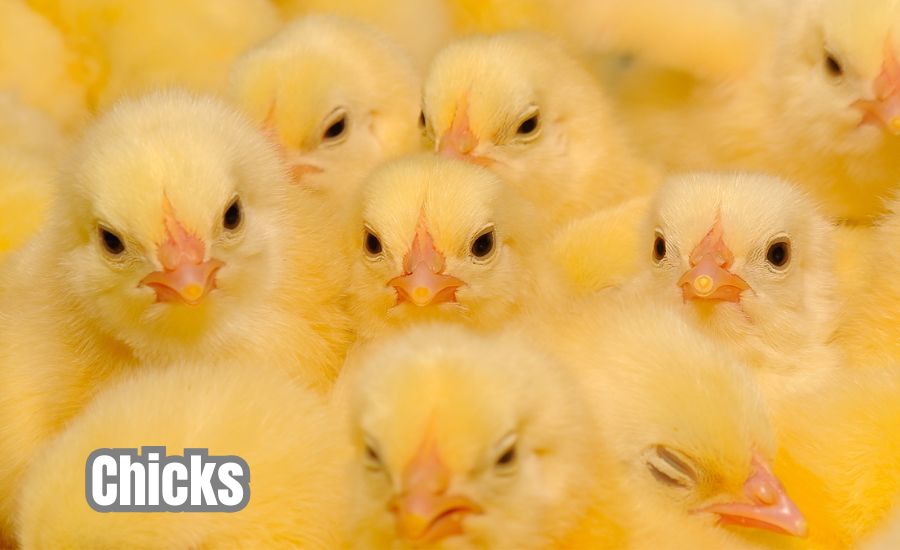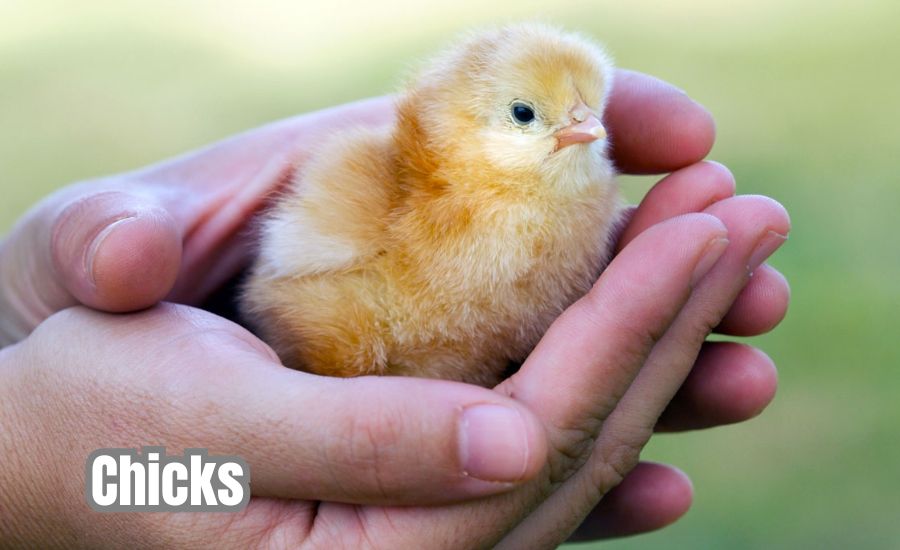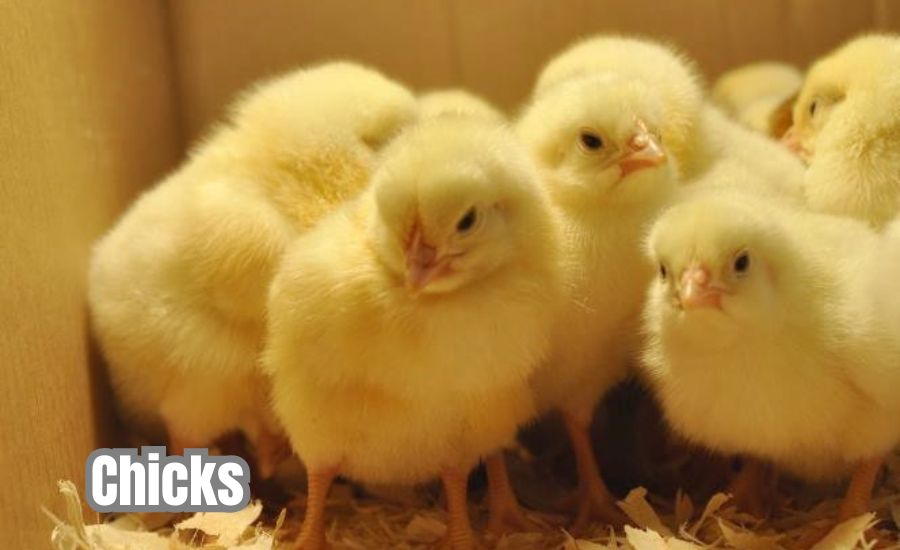Chicks are tiny balls of fluff that bring bright smiles. Chicks need gentle hands, warm light, and clean water to grow strong. In this fun guide from Vista Glimpse, we’ll walk together through every peep, hop, and flutter so your little flock stays safe and happy.
Watching baby birds explore their new world is pure magic. With a few simple tips, you can give Baby chickens everything they need—room to stretch, tasty feed, and a cozy brooder that feels like home. Let’s dive in and turn your back-yard into a fluffy wonderland!
Chicks: What Are Chicks?
Chicks are baby birds that are soft, small, and fluffy. Most people think of yellow baby chickens when they hear the word “chicks.” These tiny animals are born from eggs and need a lot of care.
Many kids and adults enjoy watching Baby chickens grow. It is fun to see them learn to walk, eat, and peep. They are full of energy and always moving around.
Every chick starts inside an egg. After staying warm for a few weeks, they hatch out and begin their new life. This is the first stage of a chick’s life.
Baby chickens are not toys. They need gentle hands and careful love. If you want to raise Baby chickens, you need to learn how to keep them safe and healthy.
Why Chicks Love Warm Homes
Warmth is very important for baby chicks. They cannot keep their bodies warm on their own when they are little. That is why they need a heat lamp or warm brooder.
Without a warm home, Baby chickens may get cold and sick. They will huddle together and stop eating or drinking. This is dangerous for their health.
A brooder is like a cozy bedroom for Baby chickens. It has soft bedding, warm light, and space to move. It helps them feel safe and grow strong.
Checking the temperature often is a good idea. A happy chick will run and play. A cold chick will sit still and look sad.
Best Food for Happy Chicks

Good food helps chicks grow fast and strong. They need a special kind of food called starter feed. It has all the things their tiny bodies need.
Starter feed is made just for Baby chickens. It is soft and easy to eat. You can buy it at farm stores or pet shops. It comes in small crumbles.
Always keep the food clean and dry. Wet or dirty food can make Baby chickens sick. Change the feed every day to keep it fresh.
You do not need to give them grit at first. Their starter feed is enough. Wait until they grow bigger before giving other kinds of food.
Safe Bedding Tips for Tiny Chicks
The floor of the chicks’ brooder should be soft and clean. Bedding keeps them warm and gives them a place to walk and rest. Pine shavings are a good choice.
Do not use sawdust or sand. Baby chickens might eat it by mistake, and that can hurt their tiny bellies. Choose bigger shavings instead.
Make the bedding 1 to 3 inches deep. If the floor is cold, add more. This keeps the Baby chickens comfy and warm.
Turn the bedding every few days. This keeps it fresh and dry. Dirty bedding can smell bad and make Baby chickens feel unwell.
How to Set Up a Chicks Brooder
A brooder is a warm and safe space for baby chicks. You can make one using a big box, tub, or cage with high sides.
Use a lamp with a 250-watt bulb to give heat. Hang it above the brooder, not too low, so it doesn’t burn the Baby chickens.
Place a thermometer at floor level. Keep the temperature around 95 degrees in the first week. Lower it a little each week.
Add soft bedding, clean water, and feed trays. Make sure the Baby chickens have space to move toward or away from the heat.
Chicks and Water: Simple Rules
Chicks need water all the time. Fresh, clean water helps them stay healthy and happy. Use shallow water trays to keep them safe.
Cold water is not good for tiny Hatchlings. It can make them feel cold inside. Room temperature water is best.
When your Hatchlings first arrive, dip their beaks gently in the water. This helps them learn where to drink.
Change the water two times a day. If it gets dirty, change it right away. Clean water is very important.
Common Mistakes When Raising Chicks

One big mistake is not keeping chicks warm enough. If they are cold, they stop eating and may get sick. Always check their brooder temperature.
Another mistake is giving dirty water or old food. This can cause tummy troubles and make your Hatchlings sick. Keep things fresh every day.
Using the wrong bedding is also a problem. Small bits like sawdust can be harmful if Hatchlings eat them. Use big pine shavings instead.
Don’t hold the chicks too much in the first few days. Let them rest and get strong before lots of play.
Chicks Growing Up: Week-by-Week Guide
In the first week, chicks sleep a lot. They eat, drink, and stay close to the heat. Keep a close eye on them.
By week two, Hatchlings start to grow tiny feathers. They also become more active. Make sure they have enough space to move.
In week three and four, the Hatchlings will be much braver. They run around and play with each other. They also start looking like mini chickens.
After week five, you can slowly lower the heat. Get ready to move them to a bigger coop when they are strong and feathered.
Fun Facts About Chicks for Kids
Chicks can talk before they hatch! They peep inside the egg and talk to their mom and siblings. Isn’t that cute?
Some Hatchlings have fluffy feet, and some have none. They come in many colors like yellow, black, and even brown.
Baby Hatchlings grow fast. In just six weeks, they can look like grown chickens. That’s super quick!
Chicks love music. Some farmers say they peep more when they hear soft songs. Try it and see!
Chicks and Friends: Keeping a Friendly Flock
Chicks love having friends. They feel safe in groups. Never raise just one chick alone.
If a chick gets bullied, watch closely. Sometimes one chick may peck at others. Separate it if needed.
Give each chick enough space. Too little room can make them fight. More room means more peace.
Add toys or mirrors in the brooder. Chicks like to look and play. It keeps them happy and busy.
Health Checks: Spot Sick Chicks Early
Watch your chicks every day. If one chick looks sleepy or doesn’t eat, it might be sick. Early help can save it.
Check their poop. Healthy poop is brown and white. Runny or red poop is a warning sign.
Look at their eyes and nose. They should be clean, not wet or crusty. Sneezing Hatchlings need care.
A sick chick should rest in a warm, quiet place. Ask a vet for help if you are unsure.
You Need To Know: Cocky Leekie Soup Recipe
Outdoor Playtime: When Chicks Can Explore

Chicks love sunshine and fresh air. But they can only go outside when it’s warm and safe.
Wait until they are fully feathered. This usually takes five to six weeks. Then, short outdoor time is okay.
Make sure no cats or dogs can reach them. Use a small fenced area to keep them safe while they play.
Stay close when they are outside. Hatchlings are small and can get lost or hurt easily.
Budget Tips: Caring for Chicks on Less Money
Raising chicks doesn’t have to cost a lot. Use a big cardboard box for a brooder. It works well and costs less.
You can find cheap feed in local farm stores. Buy only what you need, not big bags for just a few Hatchlings.
Use old bowls for food and water trays. Just be sure they are clean and safe.
Ask friends or farmers for extra supplies. Many are happy to share!
City Chicks: Rules and Smart Ideas
Some cities allow chicks, some don’t. Always check with your city rules before getting any.
Keep your Hatchlings inside a quiet garage or room. Make sure neighbors are okay with it.
Use good bedding and keep things clean. This helps avoid smells and bugs.
If you move them outside later, be sure your yard is safe and your fence is high.
Graduation Day: Moving Chicks to the Big Coop
When Hatchlings grow strong, it’s time for their big move. This is called moving to the coop.
Make sure the coop is clean and has no drafts. Add clean bedding, food, and water.
Let the Brooder setup explore slowly. Watch them for signs of stress. Keep the coop quiet at first.
Soon they will feel at home. They’ll run, flap their wings, and enjoy their new space!
Conclusion
Raising chicks is a fun and happy job. They are small, soft, and full of life. With warm homes, clean water, and yummy food, they grow into strong birds. You can watch them run, peep, and flap their wings every day.
Taking care of Hatchlings helps you learn and feel proud. Just like babies, they need love and time. If you follow all the tips in this blog from Vista Glimpse, your Hatchlings will grow up safe and healthy. Keep smiling and enjoy every peep and hop!
You Should Know: Understable
FAQs About Chicks
Q: What do chicks eat?
A: Chicks eat starter feed, which is soft and made for baby birds. It helps them grow strong.
Q: How do I keep Brooder setup warm?
A: Use a heat lamp in a brooder. Keep the temperature around 95°F for the first week.
Q: Can I raise just one chick?
A: No, Brooder setup need friends. Always raise two or more so they don’t feel lonely.
Q: When can chicks go outside?
A: Chicks can go outside when they have full feathers, usually after 5 to 6 weeks.
Q: How often should I clean their brooder?
A: Clean the brooder every few days and change bedding if it gets dirty or wet.
Q: What kind of water should Brooder setup drink?
A: Chicks need clean, room-temperature water. Change it twice a day.
Q: Can I touch my Brooder setup?
A: Yes, but only gently and not too much. Let them rest and grow.
Q: Are chicks allowed in cities?
A: Some cities allow Brooder setup. Check your city rules before bringing them home.


